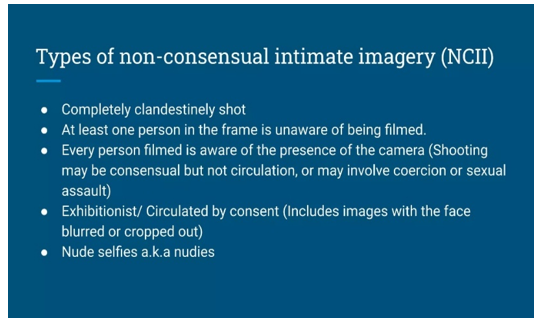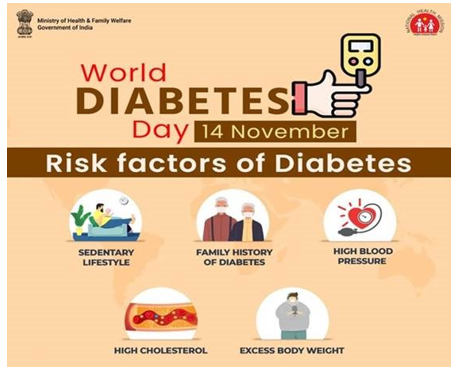Removal of Non-Consensual Intimate Imagery (NCII)
Context:
Recently, the Ministry of Electronics and Information Technology issued a victim-centric Standard Operating Procedure (SOP) to ensure the swift removal of Non-Consensual Intimate Imagery (NCII) and strengthen digital safety and privacy.
More on the News

- The SOP was released in compliance with the Madras High Court judgment in X (Social Media Platform) v Union of India that directed the swift removal of a woman advocate’s intimate images uploaded without consent.
- The High Court asked the Ministry to create a prototype to guide victims on the steps to take when Non-Consensual Intimate Imagery is disseminated.
- The SOP aims to empower individuals to reclaim control over their digital identities and ensure a safer online environment.
- The guidance aligns with the Information Technology Act 2000, the Information Technology Rules 2021, the Indecent Representation of Women Act 1986, and the Bharatiya Nyaya Sanhita 2023.
Key Features of the Standard Operating Procedure (SOP)
- The SOP allows victims to report through One-Stop Centres (OSCs), the National Cybercrime Reporting Portal (NCRP), in-app grievance mechanisms of intermediaries, or directly to local law enforcement.
- It mandates all intermediaries to remove or disable access to flagged content within 24 hours of receiving a complaint.
- It mandates that Significant Social Media Intermediaries (SSMIs) deploy hash-matching and crawler technologies to prevent re-uploads of similar content.
- The Indian Cybercrime Coordination Centre (I4C), under the Ministry of Home Affairs (MHA), will act as the central aggregator for NCII complaints and maintain a secure NCII hash-bank.
About Non-Consensual Intimate Imagery (NCII)
- NCII refers to the capture, creation, publication, or distribution of sexually explicit, nude, or partially nude photos or videos of an individual without their explicit consent.
- NCII is a criminal offence under Indian laws like the IT Act, 2000 (including Sections 66E, 67 and 67A), the Indecent Representation of Women Act, 1986, and relevant provisions of the Bharatiya Nyaya Sanhita, 2023.
World’s First Microwave Neural Network (MNN) Chip Developed
Context:
Researchers have created the world’s first microwave neural network chip that outperforms traditional CPUs.
More on the News
- This Microwave Neural Network (MNN) delivers faster and more efficient computation than traditional digital processors.
- This microprocessor uses microwaves instead of digital circuitry to perform computational tasks.
- The study was published in Nature Electronics and confirmed the creation of the first fully functional microwave neural network integrated onto a single chip.
Features of the MNN Chip
- The MNN chip leverages analogue waves in the microwave range of the electromagnetic spectrum within an AI neural network, generating a distinctive comb-like waveform pattern.
- The chip uses a neural network architecture built on electromagnetic nodes inside tunable waveguides that recognise patterns and adapt to new information.
- The chip performs both simple logic operations and advanced tasks such as binary sequence recognition and high-speed pattern detection with eighty-eight per cent accuracy.
- The processing speed of the chip exceeds that of most consumer CPUs, which function at 2.5 to 4 gigahertz.
- The chip consumes less than two hundred milliwatts, which is significantly lower than the power used by most CPUs.
Rationalisation of Royalty Rates for Critical Minerals
Context:
Recently, the Union Cabinet approved revised royalty rates for four Critical minerals to boost domestic production and reduce import dependence in strategic mineral sectors.
More on the News
- The new royalty rates approved for graphite, caesium, rubidium and zirconium used in high-tech and green energy applications.
- The decision will promote the auction of mineral blocks that contain these minerals and unlock associated critical minerals such as lithium, tungsten, rare earth elements and niobium.
- As India relies heavily on imported graphite, the royalty revision is intended to incentivise domestic exploration and extraction.
- Zirconium, caesium and rubidium are essential for sectors such as nuclear energy, electronics, telecommunications and precision instruments.
Critical Minerals
- Critical minerals are those minerals which are essential for economic development and national security.
- The “Criticality” combines a comparatively high economic importance with a comparatively high risk of supply disruption.
- India has identified 30 critical minerals, of which 24 are listed under Part D of the Mines and Minerals (Development and Regulation) Act (MMDR), 1957, giving the Centre exclusive authority to auction their blocks.
Royalty Rates for Critical Minerals
| Mineral | Royalty Rate |
| Caesium | 2% of the Average Sale Price (ASP) of caesium metal chargeable on the caesium metal contained in the ore produced |
| Graphite (≥ 80% fixed carbon) | 2% of ASP on ad valorem basis |
| Graphite (< 80% fixed carbon) | 4% of ASP on ad valorem basis |
| Rubidium | 2% of ASP of rubidium metal chargeable on the rubidium metal contained in the ore produced |
| Zirconium | 1% of ASP of zirconium metal chargeable on the zirconium metal contained in the ore produced |
Significance of the Rationalisation
- Strengthens Mineral Security: The move promotes domestic exploration and production of critical minerals, which reduces import dependence and strengthens India’s mineral security.
- Boosts Investment: The rationalised royalty structure enables competitive bidding in auctions, which improves investor confidence and unlocks associated critical minerals such as lithium and rare earth elements.
- Accelerates Clean-Energy Transition: The decision supports India’s green energy transition by ensuring a reliable supply of minerals essential for EV batteries, electronics, nuclear applications and high-tech industries.
Amendment to the PPV&FR Act
Context:
The Union Agriculture Minister announced that the Protection of Plant Varieties and Farmers’ Rights (PPV&FR) Act will be amended to strengthen farmers’ rights and improve conservation of traditional crop varieties.
More on the News
The announcement came during the Plant Genome Saviour Awards ceremony marking the Silver Jubilee of the PPV&FR Act and the 21st Foundation Day (11th November) of the Authority established under the Act.
- The Plant Genome Saviour Award Ceremony is given annually to honour individual farmers, communities, and organizations for their contributions to the conservation and improvement of plant genetic resources and traditional seed varieties.
The proposed amendments are expected to address issues such as clearer definitions of farmers’ varieties, stronger safeguards for farmers against adverse litigation, improved benefit-sharing mechanisms and streamlined registration processes for new, extant and farmers’ varieties.
Protection of Plant Varieties and Farmers’ Rights (PPV&FR) Act
The Protection of Plant Varieties and Farmers’ Rights Act, 2001, established a statutory body, the Protection of Plant Varieties and Farmers’ Rights Authority (PPV&FRA) on 11 November 2005 under the Ministry of Agriculture & Farmers’ Welfare, Government of India.
The primary objectives of the PPV&FRA are to:
- Grant intellectual property rights to plant breeders for their innovations in developing new plant varieties
- Recognise and reward farmers and communities who conserve traditional varieties and biodiversity
- Promote the protection of farmers’ rights to save, use, sow, resow, exchange, share, and sell farm-saved seed of registered varieties
- Encourage research and innovation in plant breeding and agriculture
- Maintain the National Register of Plant Varieties (NRPV) and ensure the documentation and conservation of valuable germplasm resources
The Authority is headquartered in New Delhi.
World Diabetes Day 2025
Context:
The World Health Organisation marks World Diabetes Day on 14 November annually to highlight the growing global burden of diabetes and promote a life-course approach against diabetes.
More on the News

- The theme of World Diabetes Day 2025 is “Diabetes across life stages”, which highlights the need for integrated care throughout all phases of life.
- The day is celebrated on 14 November to honour the birth anniversary of Sir Frederick Banting, who co-discovered insulin along with Charles Best in 1922.
- The WHO continues to highlight that diabetes remains a major global public health challenge that demands coordinated policy action and community participation.
- The campaign encourages awareness drives, knowledge-sharing initiatives and public engagement to prevent complications and improve the quality of life for people with diabetes.
- The first World Diabetes Day was observed in 1991, established by the International Diabetes Federation (IDF) and the World Health Organisation (WHO).
- Diabetes is a major global health concern, with approximately 589 million adults living with the condition in 2024, a number projected to rise to 853 million by 2050.
About Diabetes
Diabetes is a long-term metabolic condition in which the body cannot properly regulate blood glucose due to insufficient insulin production or ineffective insulin use.
- Insulin is a hormone produced by the pancreas that regulates blood sugar by moving glucose from the blood into cells for energy.
Diabetes occurs in several forms that include Type 1 diabetes, Type 2 diabetes, gestational diabetes, prediabetes, etc.
Diabetes develops when genetic, lifestyle and environmental factors disrupt the body’s ability to use glucose efficiently, and this leads to chronic high blood sugar.
Diabetes affects vital organs such as the heart, kidneys, eyes and nerves, and untreated or poorly managed diabetes increases the risk of serious complications.
Diabetes requires timely screening, consistent monitoring and lifestyle modifications that include physical activity, balanced diets and stress reduction.

